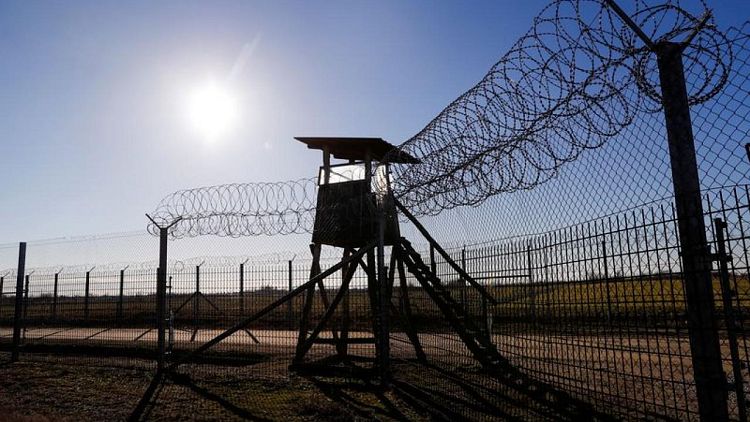By Krisztina Than
KUBEKHAZA, Hungary/RABE, Serbia - Portraying Hungary as a border fortress against illegal migration into Europe is a central theme of Prime Minister Viktor Orban's close-fought campaign for re-election on April 3, but Hungary's borders still appear increasingly porous.
France was overwhelmed by migrants, said Orban in a recent speech, while Italy's border was "as leaky as a pasta strainer" - rhetoric seen as a voter-winner in his ruling Fidesz party's rural and conservative strongholds.
Data, however, suggests that thousands of migrants successfully cross Hungary's southern borders with Serbia and Romania, part of which is fenced off and heavily guarded, then travel across the country to western Europe.
The number of illegal migrants intercepted in neighbouring Austria almost doubled to about 40,000 last year from 21,641 in 2020, with most arriving via Hungary, according to a spokesman at the Austrian interior ministry.
Frontex, the European Union's migration agency, said illegal border crossings jumped 124% on the Western Balkan route in 2021 from 2020. In January alone, Frontex recorded nearly 6,000 illegal crossings on the route, 148% more than a year ago. The migrants' top three countries of origin were Syria, Afghanistan and Turkey.
ANTI-IMMIGRATION PLATFORM
In power since 2010, nationalist Orban has campaigned on an anti-immigration platform, with his policies and tough asylum laws putting him in conflict with the European Union and drawing criticism from the United Nations refugee agency.
"Hungary is in fact the border fortress for the interior of Europe, and mainly the territories of Germany. That is where the migrants are heading," Orban said in a speech on Feb. 12. "Every day hundreds of people are trying to enter Hungary by force."
Orban also said the opposition - which has united against him for the first time - would "open the borders". The opposition's leader said they would keep the fence in place.
But for many of the migrants waiting in camps in Greece or Serbia, the Hungarian route remains an appealing one despite Orban's steel fence, built after the 2015 migration crisis, and heavy police patrols.
Last year Hungarian police detained 1,277 smugglers who tried to ship illegal migrants across the country - up from 455 the year before, police told Reuters in an emailed reply.
A Hungarian government spokesman said migration remained a "threat" and Hungary would have to "reinforce its defences, and in several respects restructure the border defence system".
"We believe we'll have to involve new forces," the spokesman said, adding "there are always as much of our forces at the border as necessary."
'NO FUTURE'
Near the village of Rabe in Serbia, just a few kilometres from the point where the borders of Hungary, Serbia and Romania meet, around 20 migrants camp out inside a derelict building in freezing cold. They are without any basic amenities, with the floor of one room covered in human excrement.
Some had been there for weeks, making repeated attempts to cross into Hungary despite thermal security cameras and drones deployed by Hungarian border police.
Mohamed Khalid, 45, who fled war in Syria, said he was heading for Germany to earn money to send back for his six children. He had tried crossing into Hungary three times, only to be caught and sent back by police.
"No, no, no," he said, when asked if he would stop trying to cross the border. "Where (would) I go?", he added, saying there was "no future" in Syria.
Another man from Syria, who did not want his name used, said he had tried crossing seven times. As darkness fell, he and two friends, one with a backpack, started walking towards the border for another attempt.
Under Hungarian law migrants cannot make an asylum application at the border, only at two dedicated embassies, which triggered a conflict with Brussels. The EU's top court ruled last year that Hungary breached EU law when it considered asylum applications inadmissible if the asylum seeker arrived to Hungary via a third country considered safe - such as Serbia.
MILLIONS OF EUROS
Levente Bauko, head of the Csongrad-Csanad county police's border unit said some migrants made repeated attempts to cross.
"If I can put it that way: we have returning guests," Bauko said, adding that most scaled the fence with ladders.
Police said in an emailed reply that last year there were 122,239 illegal entries by migrants or attempted crossings on the southern border, up from 46,179 in 2020 and 17,252 in the year before.
The 1,277 smugglers detained in Hungary last year were mostly Romanian, Serbian, Hungarian, Ukrainian and Bulgarian citizens.
In January, Hungarian police fired shots at a truck carrying around 30 suspected migrants after it drove through a checkpoint near the Austria border.
In November, Austrian authorities busted a human smuggling network that had spirited more than 700 people across Hungary in cars and vans. The network charged 4,000-5,000 euros per person for the trip, raking in more than 2.5 million euros.
On Nov. 16 alone, about 25 vehicles with 200 to 300 illegal immigrants drove from the Serbian-Hungarian border to Austria at the same time.
